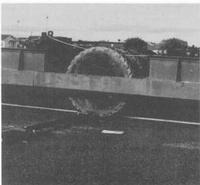


Chapter 6
I Construction During The Settlement Years
II The Use Of Timber As A Structural Material
III Structural Steel
IV Concrete Technology
V Housing
VI Industrialised Pre-cast Concrete Housing
VII Ports And Harbours
VIII Roads
IX Heavy Foundations
X Bridges
XI Sewerage
XII Water Engineering
XIII Railways
XIV Major Buildings
XV Airports
XVI Thermal Power Stations
XVII Materials Handling
XVIII Oil Industry
XIX The Snowy Mountains Scheme
XX The Sydney Opera House
XXI The Sydney Harbour Bridge
XXII Hamersley Iron
XXIII North West Shelf
Sources and References
Index
Search
Help
Contact us

This Australian technology has developed in parallel with that of similar overseas organisations, such as the United States Corps of Engineers, with whom DWH maintained close contact, to the mutual benefit of these two authorities.
A deliberate decision was made in the late 1940s in favour of maximum use of flexible pavements for runways and taxiways to provide a better riding surface for high landing speed aircraft, and of concrete for aprons to give better resistance to tortional stresses and damage from fuel spills during refuelling.
By the mid-1950s, new and very successful methods had been developed in Australia for predicting the likely in-service strength of sub-grades on which to base actual pavement thicknesses, and also for the preparation of pavement thickness design charts relating CBR strength, wheel loadings, tyre pressures and traffic densities with Australian conditions and materials. (Fig. 59 Test Rolling).

One of the most significant and successful techniques devised by DWH at this time concerned test-rolling to evaluate the strength of an existing airport pavement, predict its performance under much heavier aircraft which might wish to use it, at varying frequencies of use, and so facilitate the determination of the nature and thickness of any additional pavement needed. It involved rollers with wheel loadings and tyre pressures selected to simulate the effects of the desired aircraft, observation and measurement of the behaviour of the pavement, including deflection and recovery rates, and interpretation of these in conjunction with selective field and laboratory tests of materials. It resulted in considerable economies in airport pavement design and construction.
Australian engineers also advanced the technology for producing durable, waterproof and clean bituminous seal coats for airport pavements, including the successful use of a smaller thickness of bituminous concrete on heavy-duty pavements than is generally used overseas.
Development of technology of airport buildings has generally followed that of Architecture as a whole. There are, however, several aspects worthy of note. Considerable research has been carried out on the design of control towers, resulting in the early use of multi-sided cabins of eight and, in some more recent cases, nine faces, with glass set of 15° to the vertical to avoid reflections and shadows. Another successful feature of the design of passenger terminals is the provision of facilities for physically handicapped people. The work of DCA in this regard has received international recognition.
Aircraft noise can have an important impact on the environment near airports. Australia was one of the first countries in the world to recognise this problem. The National Acoustics Laboratory (NAL) of the Department of Health, working in association with DCA/DofA and the RAAF, became concerned with this in the early 1960s. This led to Australia taking a leading role in the consideration of Aircraft Noise by ICAO and the preparation in 1970 of Annex 16 to the Chicago Convention, establishing maximum permissible noise levels for aircraft in their operation at and near airports. The same combination of Commonwealth Authorities has, more recently and using computer technology, developed innovative methods of producing the Noise Exposure Forecast contours used in evaluating the effect of aircraft noise in the vicinity of airports.
Organisations in Australian Science at Work - Australia. Department of Civil Aviation (D.C.A.); Australia. Department of Housing and Construction (D.H.C.); Australia. Department of Works and Housing (D.W.H.); Australia. National Acoustics Laboratory (N.A.L.); CSIRO; International Civil Aviation Organization (I.C.A.O.); Royal Australian Air Force (R.A.A.F.)
People in Bright Sparcs - Bradfield, Dr K. N. E.
 |
Australian Academy of Technological Sciences and Engineering |  |
© 1988 Print Edition pages 395 - 397, Online Edition 2000
Published by Australian Science and Technology Heritage Centre, using the Web Academic Resource Publisher
http://www.austehc.unimelb.edu.au/tia/392.html